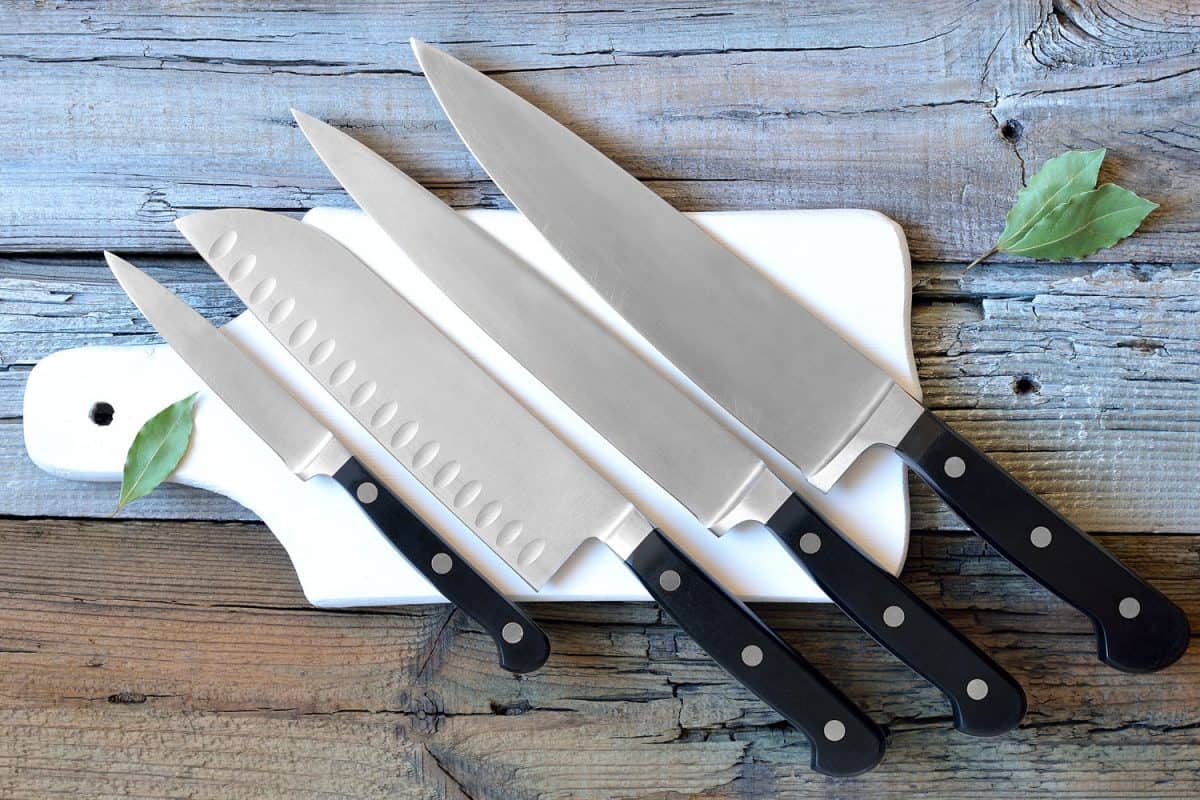Tomatoes are one of the most popular staples in everyday American cuisine. You can use them in a variety of marinara sauces, salsas, sandwiches, and other meals. But what's the best way to dice a tomato? And do they have to be diced a certain way when you prepare them? We've looked into the answers to these questions. In this post, we will answer them for you.
Here are three methods to dice tomatoes:
- Chef's slicing method
- Wide strip method
- Small cube method
Next, we'll elaborate on how to do each method properly by using the tools accessible in your kitchen. We will also cover the best knives to use for dicing tomatoes. If you're wondering the most common tomatoes to dice, we've got that answered too, along with meals in which to use them. Continue reading to learn more about how to dice tomatoes the right way.
![A woman slicing a piece of tomato on her chopping board, How To Properly Dice A Tomato [3 Ways]](https://kitchenseer.com/wp-content/uploads/2021/02/How-To-Properly-Dice-A-Tomato-3-Ways-667x1000.jpg)
3 Ways To Properly Dice A Tomato

1. Chef's Slicing Method
- Start by washing the tomato to remove any dirt and debris.
- Next, use a serrated knife to first core the tomato and then cut it in have lengthwise across the top. You should be able to see the entire seed chamber on the inside.
- Gently squeeze the tomato to press out the seeds. You can also use a small paring knife or your finger to remove seeds from the chambers.
- Take the seeded tomato halves and lay them with the cut side facing down on your countertop or a cutting board.
- Take your serrated knife, hold it parallel to the cutting board, and cut the tomato halves into slices horizontally. Make these slices as thin or thick as you want.
- Now cut the stack of tomato slices into strips to dice them and then slice them crosswise with the knife.
2. Wide Strip Method
- Wash the tomato in the sink with antibacterial dish soap to remove any dirt and debris.
- Take a small table knife or your finger and remove the seeds from the inside of the tomato. Now, take your knife, and cut the tomato into small strips. Then reposition the tomato to dice it, just as you would an onion.
- Next, cut a very thin slice from the bottom of the tomato to create a flat surface. Position your knife parallel to the tomato, and starting at the top, cut wide strips curving down to the bottom of the tomato. As you do this step, be sure to separate the inner core from the tomato's flesh.
- Continue to cut the flesh and leave the seedy section of the tomato inside the core and discard it. Next, cut all the strips lengthwise or as thick as you wanted the dice has to be, and then turn the slices 90° and cut the strips crosswise.
See a great demo below, featured on YouTube, for this method:
3. Small Cube Method
- First, wash and dry all of the tomatoes and be sure to remove the stickers from the skin.
- Take a chef's knife or a pairing knife and remove the tomato's core and stem.
- Next, slice through the tomato vertically using a swift motion so that you do not squish or dent it.
- Then slice the tomato halves in half. Afterward, you should have eight pieces of tomato.
- Next, take each of the eight pieces and slice them into thirds.
- Toss the tomatoes in a salad or a freezer bag for later use.
What tomatoes are best for dicing?
The most common way to eat tomatoes is by dicing them and adding the pieces into a dish. But what tomatoes are best for dicing? Let's take a look.
Grape tomatoes
Grape tomatoes are very small, but that doesn't mean that they aren't perfect for dicing and tossing into a salad or eating alone as a snack. If you prefer a tomato that isn't as juicy as Roma or cherry varieties, grape tomatoes may be the perfect pick for your meal prep.
Roma tomatoes
Roma tomatoes are the perfect size for dicing. Their long tubular shape makes it really simple to cut the tomatoes horizontally, and they are great for making sauces or pasta dishes. They provide a juicy and naturally sweet flavor to any meal, whether they're diced or cut into quarters.
Vine Tomatoes
Tomatoes on the vine are still attached to the vine to take one when you purchase them. This helps to extend their shelf life. These medium-sized round tomatoes can be sliced and diced and added to sandwiches, used for bruschetta, or simply canned and stored in the pantry.
Beefsteak tomatoes
Beefsteak tomatoes are great for dicing, and they also have very high vitamin C content, an immune-boosting antioxidant. They work well sliced or diced on hamburgers and sandwiches. These tomatoes have a mild and juicy taste that makes them perfect for sauce making and canning.
Cherry tomatoes
Though cherry tomatoes are small bite-sized varieties, they can be diced for salads or tasty pasta dishes. It's important to exercise caution when slicing these tomatoes, and it's best to do it with a small knife such as a paring knife or a small serrated knife. Or, if you don't want to slice these small tomatoes, you can throw them on skewers for delectable kebabs.
Heirloom tomatoes
Heirloom tomatoes are one of the most common varieties, especially when it comes to dicing. Their robust and sweet flavor makes them perfect for various dishes, including pasta, stews, and pizza. You can even eat these juicy tomatoes whole with a little bit of salt and pepper. Dicing them is fairly easy as they are almost completely round and are fairly dense when they are ripe.
Green tomatoes
Green tomatoes are also great for dicing. They go especially well with southwestern dishes such as cornmeal, dirty rice, and jambalaya. Green tomatoes have a slightly sour and tangy taste, making them perfect for relish and other condiments. These tomatoes have a very firm texture, so you can even dice these tomatoes with a knife that isn't super sharp, though a paring knife is ideal. When thinly sliced, they make for excellent add-ons for sandwiches and meats.
Can you dice tomatoes in a food processor?
Yes, you can definitely dice tomatoes in a food processor. However, if you are looking for perfectly cut squares like the type you would achieve if you slice the tomatoes with a knife, then a food processor is not the best option. If your food processor has a pulse feature, it can provide the closest alternative to hand-dicing tomatoes. You also benefit from first slicing the tomatoes in two halves before throwing them in the processer.
Click here to see this food processor on Amazon.
What knife is used for dicing?

With so many brands and types of knives available today, it can be hard to find the perfect knife for your daily kitchen needs. This can be especially true when it comes to slicing and dicing vegetables. Which knife is the best? Which knives are most commonly use? Let's discuss.
The Chef’s Knife
The chef's knife is probably the most used knife and many kitchen restaurants. Not only can you break down and cut up any vegetables using this knife, but you can also use it for the quick rock chop when you want to create very small pieces.
It's perfect for cutting hardy vegetables such as winter squash and even fruits such as watermelon or grapefruit. Soft vegetables such as tomatoes will seem like butter when using a chef's knife, making it easy to dice them completely in a matter of seconds.
Click here to see this chef's knife on Amazon.
Gyuto Knife
Another knife commonly used to cut vegetables is the Gyuto knife. It's a Japanese-inspired version of the classic chef's knife. The Gyuto knife is a bit thinner and is double-beveled on both sides. So to say, this knife is definitely sharp enough to get the job done.
What makes it so great at veggie cutting is that it can cut a wide variety of veggies, including the hardy veggie such as potatoes and squash and softer vegetables such as tomatoes, leafy greens, and zucchini. You can chop, dice, and fillet with this blade without worrying about wrist fatigue. If you are looking for a medium-priced blade to get the job done, this is it.
Click here to see this Gyuto knife on Amazon.
The Nakiri Knife
The Nakiri Knife is a Japanese-style vegetable knife with a flat straight blade, and it's perfect for dicing, chopping, and rock-chopping. You can find this knife online or at any home appliance store. It can range and price with some starting as low as $20 and going as high as a few hundred dollars.
The cool thing about this knife is that it's pretty versatile, and you can use it to also soft meats and fruits. It is ideal for veggies and is guaranteed to make your life easier than simply using your run-of-the-mill kitchen knife for the task.
Click here to see this Nakiri knife on Amazon.
Paring Knife
And last, we have one of the staples tools of most kitchens, the paring knife. The cool thing about the paring knife is that it's not only good at cutting vegetables, but it can be useful for a variety of cooking applications. You can use it to cut meat, peel fruits, and slice vegetables. Though it may be tiny compared to the other knives on this list, it doesn't mean that it's any less useful.
This knife has a sharp tip and a straight edge and can be the perfect multi-purpose tool for your general cutting needs. You can find paring knives available online or at local stores for about $10, but they can go as high as $100 depending on the brand and the features you're looking for.
Click here to see this paring knife on Amazon.
Should you cut tomatoes with a serrated knife?
Yes, you can cut tomatoes with a serrated knife, and many people prefer it to chef's knives. It's really a matter of personal preference. However, as long as the knife is sharp, you can use both to achieve great cuts and slices.
What can you cook with diced tomatoes?
There are several things that you can do with diced tomatoes. Let's look at a few ways to add them to your meals.
Pico De Gallo
A staple and traditional Mexican cuisine, pico de gallo is made from diced tomatoes, jalapeno, onion, and cilantro. The diced tomatoes help bring this flavorful dish to life by adding a tangy taste and soft texture.
Greek Tomato Salad
If you are a salad eater, diced tomatoes are the perfect addition to help give it a bit of flavor and texture. You can add and red onion, virgin olive oil, and a little vinegar for a simple Greek tomato salad, or add them to a garden salad to spice things up.
Chili & Pasta
Diced tomatoes often contribute to the base of a lot of pasta and chili recipes. If you don't want to dice your own tomatoes, you can purchase them already diced in cans, and some grocery stores even offer them on their fresh fruit counter.
Do you seed tomatoes for bruschetta?
It depends on your preference on how to prepare bruschetta best. While many bruschetta recipes recommend seeding the tomatoes, you can leave them in if you prefer to have a bit of texture to your bruschetta.
Can you freeze diced tomatoes?
Yes, you can freeze diced tomatoes and store them in the freezer for 12 to 18 months before they start to lose their flavor. Be sure to mark the storage date to avoid freezer burn.
Wrapping Things Up
Now that you know how to dice tomatoes, pick your preferred method, and toss them into several of your favorite dishes. Before you go, be sure to check out our other posts:
How Long Do You Let A Lasagna Sit?
How Big Is A Standard Springform Pan?








![Kitchen knife with black handle on wooden board made of beech. What Can You Cut With A Paring Knife [How About Meat]](https://kitchenseer.com/wp-content/uploads/2021/09/Kitchen-knife-with-black-handle-on-wooden-board-made-of-beech.-What-Can-You-Cut-With-A-Paring-Knife-How-About-Meat-250x250.png)


![Black food processor and other accessories on it on a white countertop, How To Dice With A Kitchenaid Food Processor [In 4 Easy Steps!]](https://kitchenseer.com/wp-content/uploads/2022/07/Black-food-processor-and-other-accessories-on-it-on-a-white-countertop-250x250.jpg)